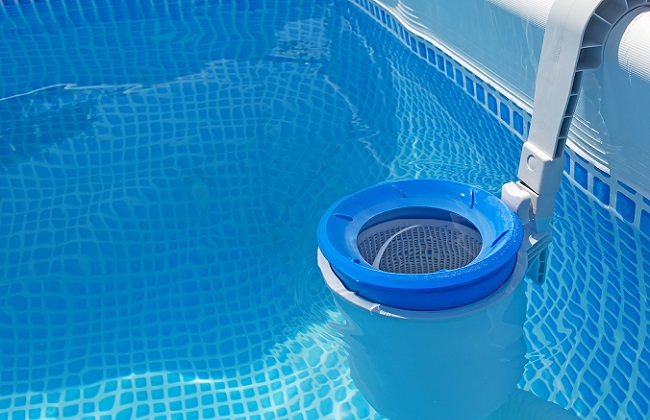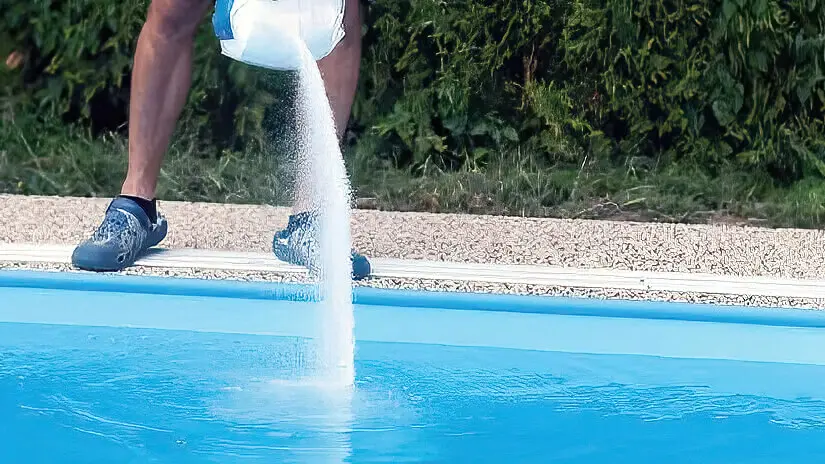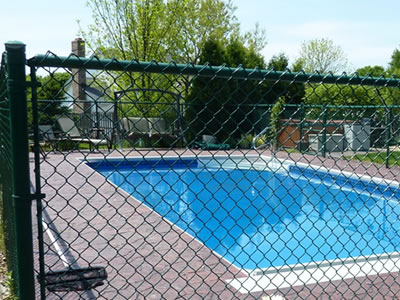Having a backyard swimming pool can be a great way to be active have fun, or just relax. It can be a full-time costly job if you don’t have any experience no matter how big your pool is. How do you treat pool water for the first time?
Follow these steps:
- Skim the surface for debris
- Vacuum pool bottom
- Test H2O chemistry
- Balance pH, chlorine, alkalinity, & calcium hardness
- Shock pool to kill bacteria & algae
- Run the filter system continuously for 24-48 hrs.
- Establish daily filtration routine (8-12 hrs.)
- Inspect & maintain equipment regularly
Introduction:
Nothing quite like the excitement of seeing your pool filled with water for the first time. After all the planning, construction, and anticipation, the sight of a crystal-clear pool can be incredibly satisfying. However, the journey doesn’t end with filling the pool. Proper maintenance is crucial from the very beginning to ensure your pool remains a safe and enjoyable oasis. Neglecting essential maintenance tasks can lead to water quality issues, equipment damage, and costly repairs. By taking the right steps immediately after filling your pool, you set the foundation for a pristine swimming environment and prolong the life of your investment. This guide will walk you through the essential steps to take right after your pool is filled, ensuring it stays in perfect condition for you and your family to enjoy.
How to Treat Pool Water For The First Time
After filling your pool with water, the next crucial steps are to ensure its cleanliness and chemical balance. Start by skimming the surface to remove debris and vacuuming the pool bottom to eliminate any settled dirt. Test the water chemistry, including pH, chlorine levels, alkalinity, and calcium hardness, and adjust as needed to maintain optimal balance.
Shock the pool to eliminate bacteria and algae, then run the filter system continuously for 24-48 hours to thoroughly circulate and clean the water. Establish a daily filtration routine for ongoing maintenance and regularly inspect and maintain pool equipment to ensure efficient operation. These steps will help you enjoy a clean, safe, and inviting swimming environment.
Step 1: Initial Cleaning
After filling your pool with water, the first step is to ensure it’s free from any unwanted debris. Start by skimming the surface of the water to remove leaves, insects, and other floating debris. This not only makes the pool more inviting but also prevents the filtration system from becoming clogged. Use a long-handled skimmer net to reach across the pool and collect all visible debris.
Next, it’s essential to clean the bottom of the pool, where dirt and small particles tend to settle. Use a pool vacuum to clean the pool floor thoroughly. Manual vacuums can be attached to your pool’s filtration system, while automatic or robotic vacuums can be left to do the work on their own. This step ensures that the entire pool is clean and ready for the next stages of maintenance. Keeping the pool clean from the start helps maintain water clarity and prevents the growth of algae and bacteria.
Step 2: Balancing the Water Chemistry

Ensuring your pool’s water chemistry is balanced is crucial for maintaining a safe and enjoyable swimming environment. Begin by using a pool testing kit to measure the pH, chlorine levels, alkalinity, and calcium hardness of the water. Accurate readings from your test kit will guide you in making the necessary adjustments.
Adjust pH Levels
The ideal pH range for pool water is between 7.2 and 7.6. If the pH level is below this range, add a pH increaser (sodium carbonate) to raise it. Conversely, if the pH level is above the ideal range, add a pH decreaser (sodium bisulfate or muriatic acid) to lower it. Maintaining the proper pH level is essential for preventing irritation to swimmers’ eyes and skin and for optimizing the effectiveness of chlorine.
Alkalinity
Total alkalinity acts as a buffer for pH, helping to keep it stable. The ideal alkalinity range is 80-120 parts per million (ppm). If your pool’s alkalinity is too low, add an alkalinity increaser (baking soda). If it’s too high, you can lower it by adding muriatic acid or sodium bisulfate. Proper alkalinity levels prevent rapid pH fluctuations, which can lead to maintenance issues and discomfort for swimmers.
Calcium Hardness
Calcium hardness refers to the concentration of calcium ions in the water. The ideal range for calcium hardness is 200-400 ppm. If the level is too low, add a calcium increaser (calcium chloride) to prevent the water from becoming corrosive and damaging pool surfaces and equipment. If the calcium hardness is too high, you may need to partially drain the pool and refill it with fresh water to dilute the calcium concentration.
Chlorine Levels
Chlorine is essential for disinfecting your pool water and keeping it free from harmful bacteria and algae. The ideal chlorine level is between 1-3 ppm. To maintain this range, add chlorine tablets or liquid chlorine. Regular testing and adjustments are necessary to ensure the water remains sanitized and safe for swimming.
Shock the Pool
Shocking the pool involves adding a high dose of chlorine to the water to eliminate bacteria, algae, and other contaminants. This is particularly important after filling your pool for the first time or after heavy usage. To shock your pool, follow the instructions on your chosen chlorine shock product, typically adding it in the evening when the sun is down to prevent UV degradation. This step helps to reset the water chemistry and ensures a clean, clear pool ready for regular use.
Step 3: Shock the Pool

Shocking the pool is a critical step in maintaining clean and safe water, especially after filling your pool for the first time.
Why Shock?
Shocking the pool involves adding a large dose of chlorine or another chemical to rapidly raise the chlorine level and oxidize contaminants. This process eliminates bacteria, algae, and other organic materials that regular chlorine treatments may not fully address. Shocking ensures that your pool water is sanitary, clear, and free of harmful microorganisms.
How to Shock
To effectively shock your pool, follow these steps:
- Choose the Right Product: Select a chlorine shock product suitable for your pool. There are various types, including calcium hypochlorite (cal-hypo), sodium di-chlor, and non-chlorine shock (potassium monopersulfate).
- Read the Instructions: Carefully read and follow the manufacturer’s instructions on the shock product packaging. This will provide specific guidance on the amount of product to use based on your pool’s size and current chlorine levels.
- Prepare the Pool: Ensure the pool’s filtration system is running. This helps to distribute the shock evenly throughout the water.
- Add the Shock: Typically, it’s best to add the shock in the evening or at dusk. This timing minimizes the loss of chlorine due to UV rays from the sun. Dissolve the shock product in a bucket of water if recommended by the manufacturer, then evenly pour it around the perimeter of the pool.
- Allow Time to Work: Let the pool water circulate overnight. Keep the filtration system running to ensure thorough mixing and distribution of the shock.
- Re-Test the Water: After allowing the shock to work for 12-24 hours, test the water again to ensure chlorine levels have returned to the safe range of 1-3 ppm before allowing swimmers to enter the pool.
Shocking your pool regularly, typically once a week or as needed, helps maintain optimal water quality, ensuring a safe and pleasant swimming experience for everyone.
Step 4: Run the Filter System
Proper filtration is essential for maintaining clean and clear pool water. After shocking your pool, the next step is to ensure your filtration system is running efficiently.
Initial Run
After filling and shocking your pool, it’s crucial to run the pool filter continuously for 24-48 hours. This initial run helps to circulate the water thoroughly, ensuring that any remaining debris, contaminants, and chemicals are filtered out. Continuous filtration during this period is essential for distributing the chemicals evenly throughout the pool, which helps in balancing the water chemistry effectively.
Regular Filtration
Once the initial run is complete, establish a routine for regular filtration to maintain water clarity and quality. Aim to run your pool filter for 8-12 hours a day. The exact duration can vary based on factors such as pool size, usage, and environmental conditions, but a general guideline is to filter all the water in the pool at least once a day.
- Timer Use: Consider using a timer to automate the filtration process, ensuring consistent operation each day without needing manual intervention.
- Monitor and Adjust: Regularly monitor the pool’s water quality and adjust the filtration time if necessary. During periods of heavy use or extreme weather conditions, you may need to run the filter longer to maintain optimal water clarity.
- Backwashing and Cleaning: Regularly backwash your filter (if you have a sand or DE filter) or clean the filter cartridges to ensure the system operates efficiently. A clean filter is essential for maintaining good water flow and effective filtration.
By consistently running the filtration system, you help to remove debris, distribute chemicals, and prevent the growth of algae and bacteria, ensuring your pool remains a safe and inviting place for swimming.
Step 5: Inspect and Maintain Equipment

To keep your pool in pristine condition, ongoing maintenance is essential. This includes regular water testing, cleaning, and monitoring of water levels.
References:
Center for Disease Control (CDC)-Healthy Swimming- Swimming and Your Health





